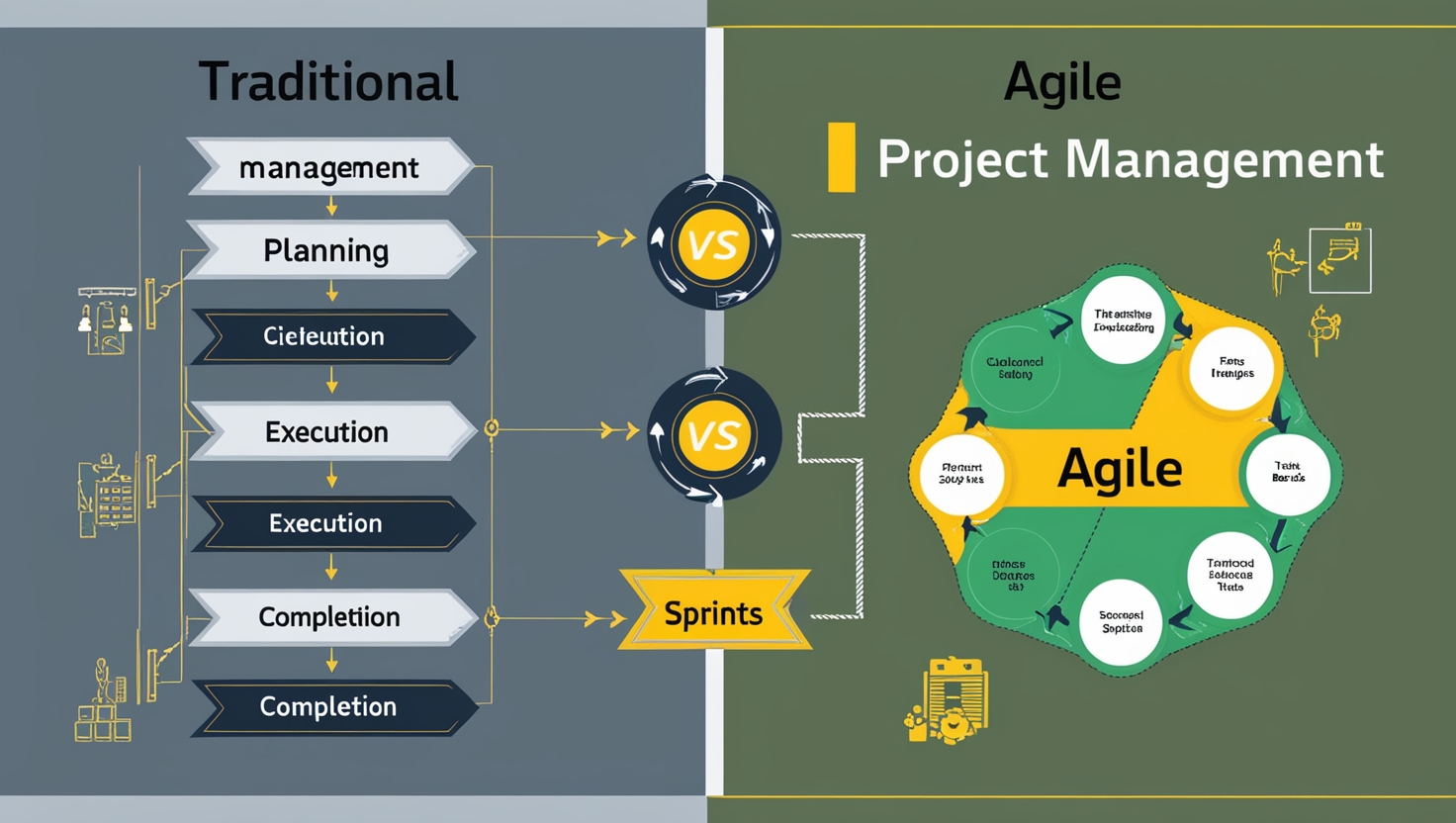Traditional Project Management vs Agile Methodology
Did you know that 71% of organizations report using agile approaches sometimes, often, or always? This surprising statistic highlights the growing shift from traditional project management to agile methodology in recent years. As we delve into the world of project management, I’ll explore the key differences between these two approaches and help you understand which might be the best fit for your organization.
The Evolution of Project Management
Traditional project management has been the cornerstone of large-scale projects for decades. It’s a linear, sequential approach that follows a strict set of phases: initiation, planning, execution, control, and closing. This method has served industries well, especially those with well-defined goals and stringent regulatory requirements.
On the other hand, agile methodology emerged as a response to the rapidly changing landscape of software development. It emphasizes flexibility, collaboration, and continuous improvement. As someone who has witnessed the transition firsthand, I can attest to the transformative power of agile in addressing the challenges of dynamic project environments.
Key Differences in Approach
Planning and Execution
In traditional project management, we meticulously plan every detail upfront. I’ve seen project managers spend weeks, even months, crafting comprehensive project plans. The execution phase then follows this plan to the letter. While this approach provides predictability, it can be rigid and slow to adapt to changes.
Agile, in contrast, embraces change. We plan in short bursts, typically in two-week “sprints.” This iterative approach allows us to adjust our course quickly based on feedback and changing requirements. I’ve found that this method is particularly effective in projects where the end goal might evolve over time.
Team Structure and Roles
Traditional projects often have a hierarchical structure with a project manager at the helm. In my experience, this clear chain of command can be beneficial for large teams working on complex projects. It provides a single point of responsibility and clear division of labor.
Agile teams, however, are typically small and self-organizing. We emphasize collective ownership and quick decision-making. I’ve seen this flat structure foster creativity and innovation, as team members feel more empowered to contribute ideas.
Client Involvement
One of the most significant differences I’ve observed is in client involvement. Traditional projects often have low client involvement until the end, which can lead to misaligned expectations. In contrast, agile methodology encourages continuous client feedback throughout the development process. This approach has helped me deliver products that closely match client expectations, reducing the need for major revisions at the end.
Documentation and Deliverables
Traditional project management places a heavy emphasis on comprehensive documentation. While this can be crucial for regulatory compliance and knowledge transfer, I’ve seen it sometimes slow down progress.
In agile, we prioritize working software over extensive documentation. This doesn’t mean we don’t document at all, but rather that we focus on what’s necessary to move the project forward. I find this approach particularly useful when dealing with rapidly evolving technologies or market conditions.
Choosing the Right Approach
In my years of experience, I’ve learned that the choice between traditional and agile project management isn’t always black and white. It often depends on various factors:
- Project Size and Complexity: Traditional methods often work better for large-scale projects with complex teams and fixed resources. Agile shines in smaller to medium-sized projects where flexibility is key.
- Industry and Regulatory Requirements: Industries with strict regulatory requirements might lean towards traditional methods for their comprehensive documentation. However, I’ve successfully implemented hybrid approaches that combine the best of both worlds.
- Team Culture and Skills: Agile requires a mindset shift. I’ve found that teams accustomed to traditional hierarchies might need time and training to adapt to the self-organizing nature of agile teams.
- Project Certainty: If the project requirements are well-defined and unlikely to change, traditional methods can provide a stable framework. For projects with evolving requirements or new technologies, agile’s adaptability is invaluable.
Real-World Applications
Let me share a couple of examples from my experience:
- Large Infrastructure Project: When working on a city-wide transportation system upgrade, we used traditional project management. The fixed scope, strict regulatory requirements, and large team size made this approach ideal. The comprehensive planning phase allowed us to anticipate and mitigate risks effectively.
- Software Start-up Product Development: In contrast, when I led a team developing a new app for a start-up, we embraced agile methodology. The frequent iterations and constant user feedback allowed us to pivot quickly, resulting in a product that closely matched market needs.
Transitioning to Agile
If you’re considering transitioning to agile, here are some tips I’ve found helpful:
- Start Small: Begin with a pilot project or a single team to test the waters.
- Invest in Training: Agile requires a different mindset. Provide comprehensive training to your team.
- Embrace Change: Be prepared for initial discomfort. The benefits of agile often become apparent over time.
- Communicate Clearly: Ensure all stakeholders understand the new process and its benefits.
In conclusion, both traditional project management and agile methodology have their strengths. As project managers, our role is to understand these approaches deeply and apply them judiciously based on the unique needs of each project. By doing so, we can lead our teams to success, regardless of the chosen methodology.
Also Read
Revolutionizing IT Project Management: Harnessing GenAI for Unprecedented Success
I’m a Senior Project Manager (Web Operations) with over 20 years of IT experience, specializing in web development, coding, and agile methodologies. Alongside my IT career, I’m a certified diet coach, helping individuals reverse diabetes and achieve weight loss through personalized wellness plans. On my blog codeyourwellness.in, I combine my technical expertise with my passion for health to promote holistic well-being.
